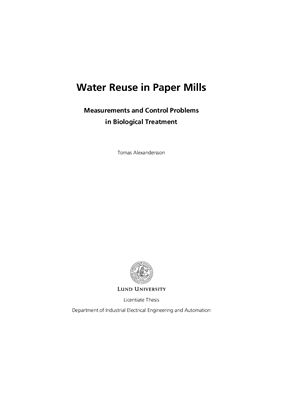Lund University, 2003. – 126 p.
Paper manufacturing is a complex and multidisciplinary science due to the diversity of paper products, used raw materials and different production processes. Besides fibres different chemicals, water and energy are needed to produce paper. The use of fresh water has decreased significantly during the last decades and there are several reasons for this, such as: limited availability of fresh water, increased cost for effluent treatment and marketing benefits.
Computer simulation is an important tool for evaluation of different controllers but requires a mathematical model of the system. Laboratory experiments were initiated to determine important parameters for such a model. Both mesophilic and thermophilic treatment of recycled fibre whitewater with a fluidised anaerobic reactor and an aerobic suspended biofilm process resulted in high removal of COD of around 90%.
Pilot tests with the purpose to study both the stability of a biological treatment process and evaluate two different on-line instruments were conducted at a packaging board mill. The results demonstrated that the removal efficiency was not markedly affected from variations of the load to the combined anaerobic/aerobic treatment process and that both instruments failed to provide stable results. Experiences from other instruments have been gathered during the assembly of a complete system consisting of a pilot plant of a biological treatment process, on-line instruments and data-acquisition equipment.
It has been demonstrated that it is possible to use on-line instruments for measurements in whitewater to acquire information about the biological treatment process. This information could be used in several different ways for the control of the addition of nutrients. Different control structures are suggested ranging from feed forward of the organic load with corrective feedback of concentrations in the anaerobic effluent to more complex model-based control structures with automatic update of model parameters.
Paper manufacturing is a complex and multidisciplinary science due to the diversity of paper products, used raw materials and different production processes. Besides fibres different chemicals, water and energy are needed to produce paper. The use of fresh water has decreased significantly during the last decades and there are several reasons for this, such as: limited availability of fresh water, increased cost for effluent treatment and marketing benefits.
Computer simulation is an important tool for evaluation of different controllers but requires a mathematical model of the system. Laboratory experiments were initiated to determine important parameters for such a model. Both mesophilic and thermophilic treatment of recycled fibre whitewater with a fluidised anaerobic reactor and an aerobic suspended biofilm process resulted in high removal of COD of around 90%.
Pilot tests with the purpose to study both the stability of a biological treatment process and evaluate two different on-line instruments were conducted at a packaging board mill. The results demonstrated that the removal efficiency was not markedly affected from variations of the load to the combined anaerobic/aerobic treatment process and that both instruments failed to provide stable results. Experiences from other instruments have been gathered during the assembly of a complete system consisting of a pilot plant of a biological treatment process, on-line instruments and data-acquisition equipment.
It has been demonstrated that it is possible to use on-line instruments for measurements in whitewater to acquire information about the biological treatment process. This information could be used in several different ways for the control of the addition of nutrients. Different control structures are suggested ranging from feed forward of the organic load with corrective feedback of concentrations in the anaerobic effluent to more complex model-based control structures with automatic update of model parameters.

